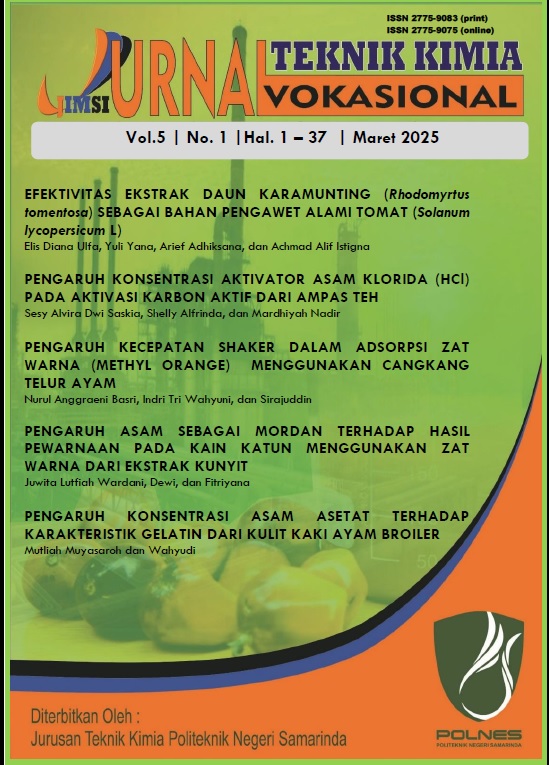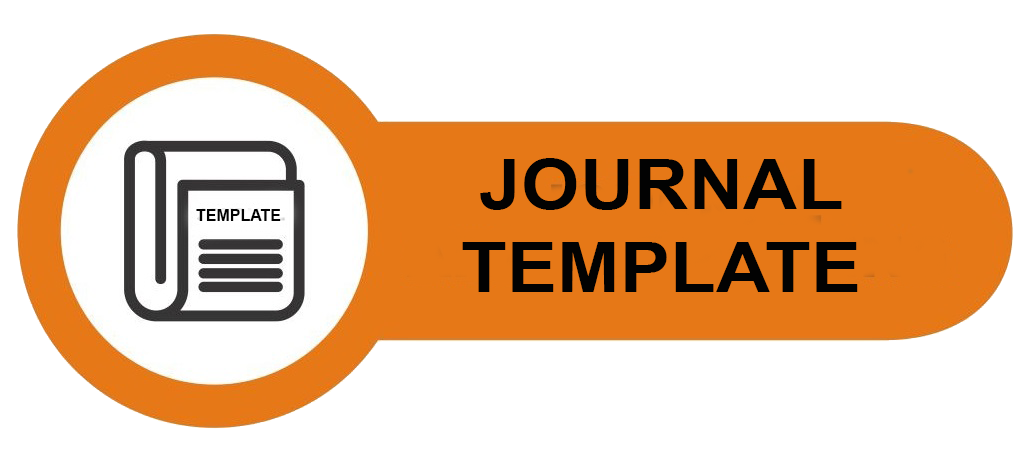PENGARUH KECEPATAN SHAKER DALAM ADSORPSI ZAT WARNA (METHYL ORANGE) MENGGUNAKAN CANGKANG TELUR AYAM
 Abstract views: 18
,
Abstract views: 18
,
 pdf downloads: 22
pdf downloads: 22
Abstract
The batik industry in Samarinda has been continuously developing from year to year. According to 2024 data, the batik industry generates wastewater amounting to 2,678,400 liters annually. This wastewater contains hazardous compounds, one of which is Methyl Orange, an aromatic azo compound characterized by a double bond (-N=N) and its carcinogenic properties. Therefore, it is necessary to treat the wastewater to eliminate the azo dye completely. One approach that can be applied is adsorption, due to its simplicity and widespread use in treating various types of pollutants. This study aims to investigate the effect of the presence or absence of a shaker on the effectiveness of eggshells as an adsorbent in reducing the dye concentration. The methods used in this research include adsorbent preparation, the adsorption process, and UV-Vis spectrophotometric analysis. Adsorption was carried out with variations in shaker speed at 120, 160, 200, 240, and 280 RPM. The results showed the highest adsorption efficiency of 57.80% at an adsorbent mass of 11 grams, pH 1, for 60 minutes, with a shaker speed of 120 RPM.
Copyright (c) 2025 JURNAL TEKNIK KIMIA VOKASIONAL (JIMSI)

This work is licensed under a Creative Commons Attribution-NonCommercial-ShareAlike 4.0 International License.
Copyright Transfer Statement
The copyright of this article is transferred to JIMSI and when the article is accepted for publication. the authors transfer all and all rights into and to paper including but not limited to all copyrights in the Psikostudia. The author represents and warrants that the original is the original and that he/she is the author of this paper unless the material is clearly identified as the original source, with notification of the permission of the copyright owner if necessary. The author states that he has the authority and authority to make and carry out this task.
The author states that:
- This paper has not been published in the same form elsewhere.
- This will not be submitted elsewhere for publication prior to acceptance/rejection by this Journal.
A Copyright permission is obtained for material published elsewhere and who require permission for this reproduction. Furthermore, I / We hereby transfer the unlimited publication rights of the above paper to Jurnal Teknik Kimia Vokasional. Copyright transfer includes exclusive rights to reproduce and distribute articles, including reprints, translations, photographic reproductions, microforms, electronic forms (offline, online), or other similar reproductions.
The author's mark is appropriate for and accepts responsibility for releasing this material on behalf of any and all coauthor. This Agreement shall be signed by at least one author who has obtained the consent of the co-author (s) if applicable. After the submission of this agreement is signed by the author concerned, the amendment of the author or in the order of the author listed shall not be accepted.
Rights / Terms and Conditions Saved
- The author keeps all proprietary rights in every process, procedure, or article creation described in Work.
- The author may reproduce or permit others to reproduce the work or derivative works for the author's personal use or for the use of the company, provided that the source and the Informatika Mulawarman copyright notice are indicated, the copy is not used in any way implying the Jurnal Psikostudia approval of the product or service from any company, and the copy itself is not offered for sale.
- Although authors are permitted to reuse all or part of the Works in other works, this does not include granting third-party requests to reprint, republish, or other types of reuse.
Jurnal Teknik Kimia Vokasional by http://e-journal.polnes.ac.id/index.php/jimsi licensed under a Creative Commons Attribution-ShareAlike 4.0 International License.








